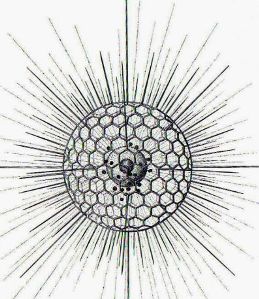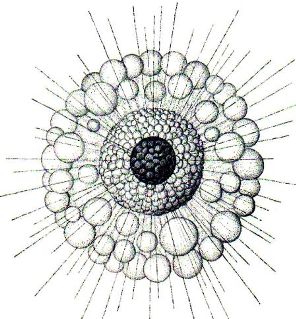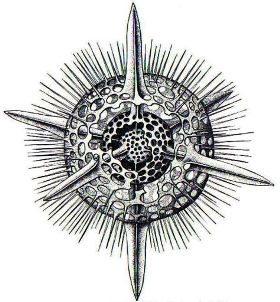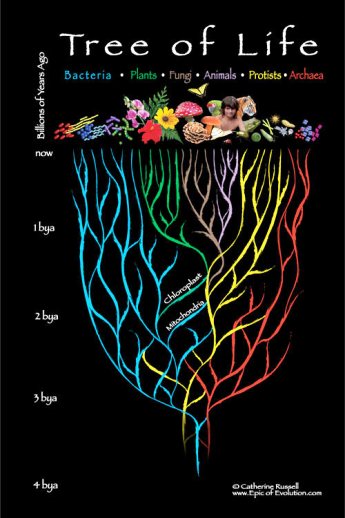THE GREAT STORY III:
THE EPIC OF EVOLUTION OF LIFE ON EARTH
(TO THE EMERGENCE OF CIVILIZATION)
Adam Blatner
Part 1: Introduction: A philosophical and psychological overview, a reflection on mythology and consciousness, and also the Summary and References.
Part 2 The Big Bang to the Formation of Planet Earth
This webpage is Part 3 The Evolution of Life on Earth
Part 4, Further Notes.
(Click here to read other papers on philosophy, etc.)
This webpage continues the Great Story, very briefly reviewing a few high points of what of course could fill several semesters and does fill many books---the emergence
This webpage will expand on the story to the left, the progression of life and and its evolution.
The earliest evidence of life goes back to almost 4 billion years ago, a relatively short time after the planet cooled. Some think that spores of primitive life were scattered in space from having evolved elsewhere in the universe---a theory called "pan-spermia." However, there remains the mystery of how life emerged in the first place, whether on this planet or some other.
The realm of elements, crystals, and the mineral level of the planet has been called the "geosphere," and upon the crust of this planet has grown up a "biosphere."
This work brought into his consciousness the awareness that the biosphere isn’t just a theoretical category, an inclusive abstraction, but rather this realm was as full of self-correcting feedback mechanisms as a living organism. Indeed, he speculated that perhaps the biosphere, to which he gave the name, Gaia, might better be appreciated if we thought of it as an actual living meta-ecological-system organism! The name Gaia is the Latin for the Goddess of the Earth. shaped by the biosphere and is not just pure mineral.
Myth-Making
To the left is a diagram by Prof. Loyal Rue about the function of myth, discussed in the first part of the lecture.The Great Story is more than a mere presentation of a chronology of events, but aims to show a sense of integrated emergence, the vitality of the principle of things moving towards more complexity, culminating in our consciousness. It offers a kind of meta-spiritual perspective. Professor Rue links our growing appreciation of cosmology, our ideas about how things ultimately are in the universe (cosmology) with an integrated narrative core---the myth---which also implies a sense of morality, what is good, bad, ideas about which things ultimately matter to humans. It involves the dimensions of collective action (institutional, ritual, experiential), our making it feel good, offer consolation, inspiration (emotional impact---aesthetic), and appealing to our intellects, that part of our mind that seeks to integrate the best elements of rationality and science with our feelings. We live in a world now that is more aware of our planetary inter-dependence, a world that needs to rise above the us-versus-them mode of not only nationalism, but also religion. As we face the challenges of, say, ecological threats to our species' existence, this new myth becomes ever more relevant.
Early Life on Earth
| This isn't pollution; virtually all
lakes harbor descendants of ancient microbes which photosynthesize but
which cannot tolerate oxygen, and thus usually remain in murky depths.
Here, at lake Ciso in Spain, abundant hydrogen sulfide and trees
protect the waters from aerating winds and the healthy Chromatium bacteria turn the lake a comely pink. |
On the left is an unusual lake---sort of like a mineral hot springs, but with a stronger concentration of that rotten-egg smelling gas called hydrogen sulfide. The bacteria who thrive there are anerobic---they feed off of the sulfur and can't abide oxygen.
To the right is a picture of the many types of anerobic bacteria that might be in that lake, living in an ecological balance: some "eat" hydrogen sulfide, others eat the chemical products of the first kind, and yet others feeding on the living or dead bodies of the first two, etc.
Incidentally, there are anerobic bacteria live at the bottom layer of the scum on your teeth---and these interact with other kinds of germs to irritate the gums and create gum disease. Flossing breaks up the biofilm, allows oxygen to kill this bottom layer, and thus prevents gum disease. This form of preventive medicine is discussed further on another webpage.
The Bacterial Catastrophe ("Holocaust"?)
The by-product of this reaction was excreted by these more adaptive and increasingly dominant types of bacteria and gradually the levels of oxygen grew in the water and then the atmosphere for over a billion years, raising oxygen from near-zero to around 20% today, where "Gaia" (many ecological-chemical reactions, the thickness of the plant biomass) keeps it in balance. (Too much oxygen and forest and prairie fires burn too brightly, taking off too much biomass; too little oxygen and plants and algae in the sea can't thrive enough. Imbalances tend to be regulated by overgrowth of one or the other types of oxygen-eating or oxygen-producing creatures.)
Because of this dynamic, probably 95% of the "old fashioned" bacteria died, became extinct! What a catastrophe (!) (??). On the other hand, a new kind of life emerged, one that had more energy and was able to develop into more complex forms.
| An animal cell, a eukaryote.Before the
electron microscope, the complexity of subtle structures within the
cell was not known. Now we are only beginning to appreciate the
complexity of sub-cellular anatomy and physiology! |
Symbiosis Produces Eukaryotes
A theory developed by Lynn Margulis is gaining more widespread acceptance. Those cells that have different parts---mitochondria---the parts that metabolize sugars into energy and carbon dioxide---, the cilia, or tiny "propeller" threads, and the nucleus, all were at one time different kinds of bacteria that worked out ways of living together in the same organism. We know know that many microscopic creatures live in this hybrid fashion. A symbiosis differs from parasitism in that in the former condition both organisms benefit from the existence of the other; whereas in parasitism the parasite benefits but the host is harmed. (There's a third mode---"commensalism," in which two organisms live together but it's not evident that either benefits from the presence of the other.)Anyway, the next major evolutionary step was the emergence of more complex cells, eukaryotes. (Bacteria don't have nuclei or mitochondria.) In this series of pictures, one hybrid creature is of special interest: A one-celled organism that lives in the gut of a termite, when examined carefully under the electron microscope, reveals that it's hairy exteria (the "trich" part of its name) really involves thousands of spirochetal bacteria who are not actually anatomically attached, but who live in close proximity, symbiosis, with the surface of the protozoan body.
70. To consider symbiosis, here’s an interesting charcter. A one celled animal living in the gut of the termite. It’s these little one-celled-animals, protozoa, that really do the digestion of the wood. Enzymes alone can’t do it. Well, electron microscopic examination of one species shows that it’s a living symbiosis of sub-cell elements—like the little seeming hairs on its body are actually separate organisms, spirochetes, spiral bacteria.
| The microbial world inside a New England termite is seen in this circle of microscopic light. |
In the hindgut wall of that organism lives the
protozoan Mixotricha paradoxica, which is actually a consortium: One
nucleated cell, |
two kinds of spirochete (e.g., on the surface, @300K tiny whip-like bacteria) to move through its viscous habitat. |
 |
 |
| Heliosphera Actinota |
Thallisicola Nucleata |
| Ophryoscolex Purkinjei |
Strombidium Arenicola |
One celled animals are especially interesting because we can enjoy the sense of astonish-mentality at the shere variety of the anatomy of these creatures: I imagine coloring them. Their life patterns---how they eat, how they reproduce---is also marvellously complex. Consider how much life can happen in the tiny space of a single cell. These folks "ruled the earth" (ha ha) for tens of millions of years before they figured out how to begin to live first in collectives and then as differentiated cells within a single larger "meta-zoan" creature, like a sponge or jellyfish. All this was about a billion years ago. (Also, getting the hang of the rhythm of their "names" is a trip! (i.e., the Latin term for their species in the classification scheme of all life, initially established by Linnaeus.)
 |
| Hexacontiumaster Acanthion |
Also, the architecture of their "shells"---how they create these out of silicon or calcium carbonate---is often remarkably complex and beautiful. Chalk, the White Cliffs of Dover, is composed of tens of millions of years of sediment of the skeletons (mainly Calcium Carbonate) of these Foraminifera, these one-celled animals.
Time Chart
For example, we didn't know that the surface of the earth not only floated on a base of very viscous liquid mantle scores of miles down---and close to the surface at places we call "volcanoes"---but these "tectonic plates" moved so that the continents drifted, collided, raised up mountain ranges, generated deep valleys, accounted for most of the earthquake phenomena we know of, and so forth. People didn't even believe in this theory for a number of years in the early 20th century!
| This picture is an imagined area of the land
mass that drifted to the south pole and became (of all things) the
Antarctic continent! |
During this middle period, jungles existing for millions of years---long before and then during the era of dinosaurs, were laying down mats of dead trees and other vegetation, and over tens of millions of years this became compressed and compressed further, creating great deposits of coal, oil, and methane-type gasses---our "carbon" deposits---which are today being used up at an escalating rate as human reproduction goes unchecked.
 |
Evolutionary Tree of Life
Arising from origins not yet fully understood, Life (the Biosphere) branched and branched again in a magnificent evolutionary process, each organism competing to find its own ecological nitch. Many species and even whole families of species become extinct---indeed, millions of them. In addition to individual extinctions, there were also a number of "mass extinctions," in which a significant percentage of all life on earth became extinct.What a symbol. It speaks to a theme that we have been emphasizing in this part-science-part-myth Great Story. The nature of complexity itself, the tendency of things to become more complex, which means both more differentiated and more integrated, is a "meme" (i.e. an idea that catches on, becomes more popular) that is infiltrating the worldview of the 21st century. It includes what's known as systems theory, the idea that the world involves systems that are both composed of sub-systems and are also part of larger systems (what the contemporary philosopher Ken Wilber calls "holarchy."
Below is another attempt to create a map, this time in a circular form (like a mandala, the psychological implications of which are discussed on another paper on this website).
The map on the left is very rough. Since the time I took biology in high school in the mid-1950s, the number of families, species, whole larger categories (e.g., "phyla") have been added to as more refined ways emerged to identify and classify new organisms (or re-classify organisms that had been noted decades earlier). Even so, the diagram to the left below, the
Dinosaurs and Extinction
But it cleared the more dominant and predatory animals away and gave little weasel-like mammals a chance to evolve, and so they did.
Which leads us to monkeys and apes and pre-humans and that part of the story:
The Evolution of Humanity
Meanwhile, there was also a great deal of evolution of other types of animals.
For example, many modern mammals didn’t exist yet, and early horses were still the size of dogs. This was the era of saber-toothed tigers and mammoths.
As for humans, slightly more complex tools were made, and some control of fire developed. Alas, it was not at all like that movie I saw in the 1940s called 1 million BC with humans and dinosaurs co-existing. Yet this myth was repeated in the popular comic strip at that time, Alley Oop.Notice above in the two charts that other species that have gone extinct lived 300,000 years ago or thereabouts, then Neanderthals, but our present species, "Homo Sapiens" (which means ''knowing or wise man" and may not be truly descriptive term, considering the foolishness that we still exhibit, for the most part) has only been recognized (by the bones) to have existed for a mere one hundred thousand years. Burial rituals seem to have been known to both homo sapiens and homo neanderthalis, and there is some evidence that the two species may have mixed genes.
Finally, as imagined in the cartoon by Gary Larson, more complex inventions began to be developed. I must note that this cartoon is technically inaccurate. Spectacles had not been invented at that time, and would not be until just before the Renaissance, around the late 14th century CE. (But I get ahead of myself: This coming fall I’ll be discussing “Little known aspects of the Renaissance.” ) Moving up rapidly, though, again, the history of humanity, the advance of each invention, of domestication of animals, the development of agriculture, of cities, etc.---all could fill many full semesters of classes.
Writing and Reflecting, the Emergence of the Theosphere
About 5200 years ago, another technology that gave birth to history, or at least the rough dividing line between pre-history and history---the earliest forms of writing and reading. (I hope to explain this technology next Springtime. )From here the story returns to the second half of the first webpage on the Great Story: What are the implications of the emergence of consciousness in this advance of complexity of systems?
Email me at adam@blatner.com